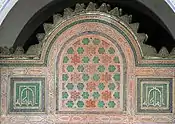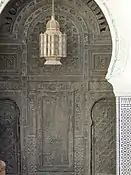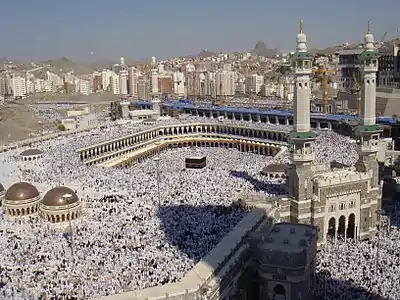Anaza
'Anaza or anaza (sometimes also spelled 'anza or anza) is a term for a short spear or staff which gained ritual significance in the early years of Islam after the Islamic prophet Muhammad planted his spear in the ground to mark the direction of prayer (qibla). It also later became an architectural term to designate an outdoor mihrab in a mosque, mainly in the Maghreb.
_in_the_city_of_Fes%252C_Morocco_(Image_8_of_9).jpg.webp)
Origins
The 'anaza was the spear (also known as a ḥarba) of the Muhammad[1] and first appears as part of Muslim ritual in the year 624 CE (2 AH), when Muhammad celebrated the first Eid al-Fitr.[2] When Muhammad and the other Muslims reached the musalla (outdoor prayer space), he planted the spear in the ground and used it to indicate the direction of prayers (the qibla), much like a mihrab would in later mosques. The spear was used in this way again on Eid al-Adha the same year. The early caliphs expanded on this practice, making it customary to carry a staff, sword, or bow on ceremonial occasions when ascending the pulpit (minbar), symbolizing authority.[1] The image of the anaza planted in front of a mihrab arch also appears on some early Umayyad coinage.[1]
Architectural feature
Perhaps related to this symbolic use as an early qibla indicator, the term "anaza" later came to be applied in to an architectural feature of many mosques in the western Maghreb and Morocco. It was used to designate an "outdoor" or "summer" mihrab, usually an ornate wooden screen that stood at the border between the sahn (courtyard) of a mosque and its interior prayer hall and which was aligned with the mosque's central mihrab axis. This anaza could thus serve as a mihrab for prayers held outside in the courtyard.[3]:296 The wooden screen was often carved and painted with a stylized mihrab motif and other inscriptions. The anaza could also be a simple mark on the pavement or floor of the courtyard in front of the prayer hall's central entrance; e.g. a semi-circular groove or recess in the middle of the step leading to the entrance.[3][4]
Wooden anazas were constructed in mosques across Morocco and the Maghreb. In Morocco they became a standard feature of "grand mosques" or Friday mosques in particular.[4]:54 The oldest surviving example is the anaza of the al-Andalusiyyin Mosque in Fez, which dates from 1209 (from the Almohad period).[4]:133 Historical sources also mention an even older anaza, dating from 1129 (during the Almoravid period), at the Qarawiyyin Mosque in Fez, but it no longer exists today and has been replaced by the current Marinid-era anaza which was fabricated between 1288 and 1290.[5] The anaza in the Grand Mosque of Fes el-Jdid, which likely dates from the mosque's construction in 1276, is very similar and might be the oldest Marinid anaza.[6][4]:133 A similar example is also found in the Grand Mosque of Meknes but was built much later in 1715 (during the reign of the Alaouite sultan Moulay Ismail).[7] Some other post-Marinid examples also include the anaza of the 16th-century Mouassine Mosque in Marrakesh (from the Saadian period).[8][3] The anaza of the near-contemporary Bab Doukkala Mosque in Marrakesh, on the other hand, is a modern replacement of the original one.[3]
 Details of the anaza of the Qarawiyyin Mosque
Details of the anaza of the Qarawiyyin Mosque Details of the anaza of the Qarawiyyin Mosque (central lower panel)
Details of the anaza of the Qarawiyyin Mosque (central lower panel) The anaza of the Grand Mosque in Meknes, dating from 1715 but copying the form of earlier Marinid examples
The anaza of the Grand Mosque in Meknes, dating from 1715 but copying the form of earlier Marinid examples
References
- Treadwell, Luke (2005). ""Mihrab and ʿAnaza" or "Sacrum and Spear"? A Reconsideration of an Early Marwanid Silver Drachm". Muqarnas. 22: 1–28. JSTOR 25482421.
- Miles, C.G. (2012). "'Anaza". Encyclopaedia of Islam, Second Edition. Brill.
- Almela, Iñigo (2019). "Religious Architecture as an Instrument for Urban Renewal: Two Religious Complexes from the Saadian Period in Marrakesh". Al-Masāq. 31 (3): 272–302. doi:10.1080/09503110.2019.1589973. hdl:10261/212691. S2CID 167107436.
- El Khammar, Abdeltif (2005). Mosquées et oratoires de Meknès (IXe-XVIIIe siècle): géographie religieuse, architecture et problème de la Qibla. Université Lumière-Lyon 2.
- Terrasse, Henri (1968). La Mosquée al-Qaraouiyin à Fès; avec une étude de Gaston Deverdun sur les inscriptions historiques de la mosquée. Paris: Librairie C. Klincksieck.
- Maslow, Boris (1937). Les mosquées de Fès et du nord du Maroc. Paris: Éditions d'art et d'histoire. pp. 38–53.
- Touri, Abdelaziz; Benaboud, Mhammad; Boujibar El-Khatib, Naïma; Lakhdar, Kamal; Mezzine, Mohamed (2010). Le Maroc andalou : à la découverte d'un art de vivre (2 ed.). Ministère des Affaires Culturelles du Royaume du Maroc & Museum With No Frontiers. ISBN 978-3902782311.
- Salmon, Xavier (2016). Marrakech: Splendeurs saadiennes: 1550-1650. Paris: LienArt. ISBN 9782359061826.
